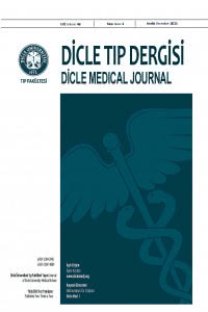Yoğun bakım ünitesinde nozokomiyal enfeksiyonların önlenmesi ve hemşirelik uygulamaları
Prevention of nosocomial infections in intensive care unit and nursing practices
___
- 1. Akdeniz S. Yoğun bakımda infeksiyon kontrol hemşiresinin rolü. Yoğun Bakım Dergisi 2002;2:9-13.
- 2. Çetinkaya Yş. Yoğun bakım ünitesi infeksiyonlarının izlemi, kontrolü ve korunma. Yoğun Bakım Derg 2002;2:16-25.
- 3. Alberti C, Brun-Buisson C, Burchardi H et al. Epidemiology of sepsisand infection in ICU patients from an interna-
- tional multicentre cohort study, Intensive Care Med 2002;28:108-121.
- 4. Karaman R. Yoğun bakım infeksiyonlarında hemşirenin rolü. Yoğun Bakım Dergisi 2002;2:5-8.
- 5. Mülazımoğlu L. Yoğun bakımda çoklu dirençli mikroorganizma sorunu. Yoğun Bakım Dergisi 2006; 6:27-29.
- 6. Çaylan R. Enfeksiyon kontrolüne yönelik genel önlemler. Yoğun Bakım Dergisi 2006;6:8-10.
- 7. Türkoğlu M. Yoğun bakımda sıfır infeksiyon, http://www.dcyogunbakim.org.tr/ppt/meldaturkoglu. pdf
- 8. Đlgün S, Ovayolu N. Yoğun bakım ünitelerinde görülen hastane enfeksiyonları ve alınması gereken önlemler, Yoğun Bakım Hemşireliği Dergisi 2005; 9:14-19.
- 9. Yorgancı K, Elker D, Kaynaroğlu V. Bir cerrahi yoğun bakım ünitesinde sağlık personelinin el yıkama alışkanlıkları. Yoğun Bakım Dergisi 2002;2:58-63.
- 10. Edinç S. Hemşirelerin Üniversal Önlemlere Đlişkin Bilgi ve Uygulamaları, Marmara Üniversitesi Sağlık Bilimleri Enstitüsü Yüksek Lisans Tezi, Đstanbul, 2006.
- 11. Slota M, Green M, Farley A, Janosky J, Carcillo J. The role of gown and glove isolation and strict handwashing in the reduction of nosocomial infection in children with solid organ transplantation. Crit Care Med 2001;29:405-12.
- 12. Harmankaya AÇ. Hastane Ortamında Sterilizasyon Uygulamaları. http://www.gata.edu.tr/infkom/HASTANE%20 ORTAMINDA %20STER%C4%B0L%C4%B0ZASYON %20 UYGULAMALARI. pdf
- 13. Erdil F, Elbaş NÖ. Cerrahi Hastalıkları Hemşireliği, 4.Baskı, Ankara, Aydoğdu Ofset, 2001, ss.84-90.
- 14. Yağmur ş. Yoğun Bakım Hemşirelerinin Hastane Đnfeksiyonlarının Önlenmesi Đle Đlgili Bilgi Düzeyi Ve Tutumlarının Belirlenmesi, Afyon Kocatepe Üniversitesi Sağlık Bilimleri Enstitüsü Yüksek Lisans Tezi, Afyon, 2004.
- 15. Kjrlen H, Andersen BM. Handwashing and disinfection of heavily contaminated hands-effective or ineffective? J Hosp Infect 1992; 21:61-71.
- 16. Doebbeling BN, Stanley GL, Sheetz CT, et al. Comparative efficacy of alternative hand-washing agents in reducing nosocomial infections in intensive care units. N Engl J Med 1992; 327:88-93.
- 17. Yorgancı K, Çakmakçı M. El yıkama: nozokomiyal enfeksiyonların önlenmesinde etkin bir yöntem. Ulus Travma Derg 1997; 3(3):164-168.
- 18. Akyol A, Ulusoy H, Ozen I. Handwashing: a simple, economical and effective method for preventing nosocomial infections in intensive care units. J Hosp Infect 2006; 62:395-405.
- 19. Eroğlu C. Hastane infeksiyonları. http://www.omu.edu.tr/~ hakan/ders / 17HAST2001.pdf
- 20. Naharcı H. Adana Đlindeki Çeşitli Hastanelerin Yoğun Bakım Ünitelerinde Çalışan Hemşirelerin Hastane Enfeksiyonlarının Önlenmesinde Etkili Olan Önlemlere Đlişkin Bilgi Düzeylerinin Belirlenmesi. Çukurova Üniversitesi Sağlık Bilimleri Enstitüsü Yüksek Lisans Tezi, Adana, 2006.
- 21. Rosenthal VD, Guzman S, Safdar N. Reduction in nosocomial infection with improved hand hygiene in intensive care units of a tertiary care hospital in Argentina. Am J Infect Control 2005; 33:392-397.
- 22. Centers for Diseas Control and Prevention. Guideline for hand hygiene in health care settings: recommendations of the helthcare infection control practices advisory committee and the HICPAC/SHEA/ APIC/IDSA hand hygiene task force. Morbidity and Mortality Weekly Report 2002; 51/RR-16. http://www.cdc.gov/mmwr/PDF/rr/rr5116.pdf
- 23. Warren DK, Quadir WW, Hollenbeak CS et al. Attributable cost of catheterassociated bloodstream infections among intensive care patients in a nonteaching hospital. Crit Care Med 2006;34:2084-2089.
- 24. Tsuchida T, Makimoto K, Toki M et al. The effectiveness of a nurse-initiated intervention to reduce catheter associated bloodstream infections in an urban acute hospital: an intervention study with before and after comparison. Int J Nurs Stud 2007; 44:1324-1333.
- 25. Aysel Đ, Moral R. Nosokomiyal enfeksiyonlar. http//www.anestezi.med.ege.edu.tr/sem/nasokomial.pdf 26. Đltuş F, Durmaz AA. Dahili yoğun bakım ünitelerinde hastane enfeksiyonlarının önlenmesi. Yoğun Bakım Hemşireliği Dergisi 2005; 9:35-40.
- 27. Hatler CW, Mast D, Corderella J et al. Using evidence and process improvement strategies to enhance healthcare outcomes for the critically ill: a pilot project. Am J Crit Care 2006;15:549-555.
- 28. Coopersmith CM, Zack JE, Ward MR et al. The impact of bedside behavior on catheter-related bacteremia in the intensive care unit. Arch Surg 2004; 139:131-136.
- 29.T.C. Sağlık Bakanlığı Enfeksiyon Kontrol Hemşireliği Eği- timi, Kateter Đlişkili Üriner Sistem Enfeksiyonlarının Önlen- mesi. http://www.rshm. gov. tr/ enfeksiyon/egitim / EKHems_sunumlar/10_uriner _sistem_enfeksiyonlari.ppt#
- 30. Aktaş F. Nozokomiyal pnömoni, Klimik Derg 2000;13:3-6.
- 31. Akalın H. Yoğun bakım hataları. Yoğun Bakım Dergisi 2002; 2:39-43.
- 32. Saltoğlu N. Ventilatör Đlişkili Pnömonin Önlenmesi ve Kontrolü, Đçinde: Öztürk R, Saltoğlu R, Aygün G., Hastane Enfeksiyonları: Korunma ve Kontrol, Đstanbul, 2008, s.89-103. http://www.ctf.edu.tr/stek/pdfs/60/6010.pdf.
- 33. Melo DS, Silva e Souza AC, Tipple AFV, Neves ZCP, Pereira MS. Nurses' understanding of standard precautions at a public hospital in Goiania - GO, Brazil. Rev Lat Am Enfermagem 2006;14:720-727.
- 34. Denton M, Wilcox MH, Parnell P et al. Role of environmental cleaning in controlling an outbreak of acinetobacter baumannii on a neurosurgical intensive care unit. Intensive Crit Care Nurs 2004;21:94-98.
- ISSN: 1300-2945
- Yayın Aralığı: 4
- Başlangıç: 1963
- Yayıncı: Cahfer GÜLOĞLU
Adıyaman’da gebe kadınlarda HBsAg ve Anti-HCV Sıklığı
Servet KÖLGELİLER, Dilek GÜLER, Hayati DEMİRASLAN
Yoğun bakım ünitesinde nozokomiyal enfeksiyonların önlenmesi ve hemşirelik uygulamaları
Sevilay YÜCEER, SEVİL GÜLER DEMİR
Kangaroo mother care as compared to conventional care for low birth weight babies
Syed Manazir ALI, Jyoti SHARMA, Rajyashree SHARMA, Seema ALAM
Yüksel KIVRAK, Sakir ÖZEN, Yavuz YÜCEL
Gebelerde toksoplasma gondii seroprevalansı
Servet KÖLGELİLER, Hayati DEMİRASLAN, Bekir KATAŞ, Dilek GÜLER
Syed Manazir ALİ, Jyoti SHARMA, Rajyashree SHARMA, Seema ALAM
Hemofagositik lenfohistiyositozis tanısında zorluklar: Olgu sunumu
FATİH MEHMET AZIK, Duygu GÜMÜŞ, Saime ERGEN, Atilla ÇAYIR
Tamamlayıcı tiroidektomi: Tek merkez sonuçları
Sadullah GİRGİN, Metehan GÜMÜŞ, Akın ÖNDER, Murat KAPAN
Migren ve gerilim başağrısı olan hastalarda anksiyete ve umutsuzluk düzeyleri
Yüksel KIVRAK, Şakir ÖZEN, Yavuz YÜCEL
Bilateral abdüktör vokal kord paralizisinde unilateral endoskopik posterior kordotomi sonuçları
